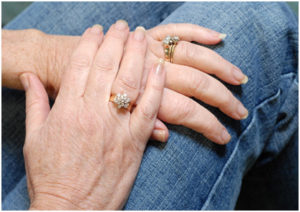Author: Dr. Stephen Chaney
 Skin damage from sun is a real danger. The dog days of summer are here. For some of us that means staying inside as much as possible. Others want to enjoy the fleeting days of summer as much as possible before summer turns to fall, and fall turns to winter. That means lots of outdoor activities in the sun – such as outdoor sports, working in the yard, and vacations in fun locations with lots of sun. So it’s time to ask the perennial question “How much sun exposure should I be getting?”
Skin damage from sun is a real danger. The dog days of summer are here. For some of us that means staying inside as much as possible. Others want to enjoy the fleeting days of summer as much as possible before summer turns to fall, and fall turns to winter. That means lots of outdoor activities in the sun – such as outdoor sports, working in the yard, and vacations in fun locations with lots of sun. So it’s time to ask the perennial question “How much sun exposure should I be getting?”
Some people like to aim for as much sun exposure as possible. When I was a teenager everybody was searching for “the perfect tan”. Back then it was popular to slather your skin with tanning oils that allowed you to just baste yourself in the sun without your skin drying up. (Did I just date myself again?)
Other people like to follow their dermatologist’s advice and use SPF maximum (the sun shall never touch my skin) sunscreens. And, just to be on the safe side they also follow their dermatologist’s advice to limit sun exposure between 10 AM and 4 PM and wear a hat, sunglasses, and protective clothing whenever possible. I can see the hat and sunglasses, but the protective clothing isn’t particularly compatible with the summer heat in my native North Carolina. Believe me, you want to wear as little as possible here in the summer.
Skin Damage From Sun
 Now that we’ve explored the extremes, let’s return to the central theme of this health tip which is “How much sun exposure should I really be getting?” Let’s start by focusing on the vanity factor – skin aging. Let’s face it. Excessive sun exposure increases the risk of skin cancer. However, skin aging is the consequence most people really care about. This is the concern that has most people reaching for the sunscreen before they head out the door.
Now that we’ve explored the extremes, let’s return to the central theme of this health tip which is “How much sun exposure should I really be getting?” Let’s start by focusing on the vanity factor – skin aging. Let’s face it. Excessive sun exposure increases the risk of skin cancer. However, skin aging is the consequence most people really care about. This is the concern that has most people reaching for the sunscreen before they head out the door.
A recent clinical study clearly showed that sunscreen usage helps prevent skin aging (Hughes et al, Annals of Internal Medicine, 158: 781-790, 2013). Now you might be saying to yourself “This is nothing new. I’ve heard that for years.” Yes, that advice has been around for a long time. But the problem is that the old advice was never based on actual clinical studies, only studies done on hairless mice. So first, let me analyze this clinical study for you and then put the findings into perspective.
The good news is that this was a very well done clinical study. The authors enrolled 903 adults under the age of 55 from sunny Australia into the study for a 4.5-year period from 1992 to 1996. The study was restricted to adults younger than 55 years because, in that age range, skin aging is primarily caused by sun exposure rather than the normal aging process. The study also excluded people who were already using sunscreen on a daily basis. Variables such as skin color, skin reaction to sun exposure, amount of time spent outdoors, sunburn history, and smoking status were determined at baseline and used to normalize the results.
Half of the participants were given a sunscreen with an SPF 15 factor and were instructed to use this sunscreen on a daily basis. The other half were given nothing and were just instructed to keep doing what they had been doing (It was deemed unethical to give them a placebo sunscreen as it could cause skin damage from sun). Compliance was assessed by measuring the weight of the returned sunscreen bottles every three months and by using a biennial application frequency questionnaire. Compliance wasn’t perfect, but of those enrolled in the sunscreen portion of the study 77% used sunscreen 3 to 4 times per week, compared to 33% of the control group.
Skin damage from sun was assessed by taking an impression of the back of the left-hand and analyzing it for the number and depth of lines and the flattening of the skin. And the results were fairly clear-cut. Those study participants who used sunscreen on a daily basis had 24% less sun damage over the 4.5-year period than the control group. I am not an expert, but dermatologists who have evaluated this study say that a 24% decrease in sun damage is visibly significant.
What Does This Study Mean For You?
It turns out that the old advice that too much sun exposure can cause significant skin damage as we get older is actually true. Who would have guessed? If the threat of skin cancer isn’t enough to dissuade you from pursuing the perfect tan, perhaps the thought of ugly, wrinkled skin as you get older will do it.
On the flip side, however, we need to remember that sun exposure is also required for vitamin D formation. And recent studies show that up to 80% of Americans have low levels of 25-hydroxy vitamin D, the biologically relevant form of vitamin D, in their blood – perhaps because many of us actually follow our dermatologist’s advice and never go out of the house without sunscreen, sunglasses, hat, and protective clothing to help prevent skin damage from sun.
Recent clinical studies have linked low levels of 25-hydroxy vitamin D with a number of health concerns. That has led one prominent dermatologist who studies vitamin D, Dr. Michael Holick, to recommend that we should be getting 10 to 15 minutes of unprotected sun exposure during midday – a recommendation that many of his colleagues consider to be heretical.
How Can You Have Your Cake And Eat It Too?
 So what is a person to do? How can we reconcile the need to improve our vitamin D status with our desire to have a healthy, good looking skin well into our golden years? The simple answer is to make sure that we are getting plenty of vitamin D in our diet. The most recent RDAs are 600 IU per day of vitamin D in children and adults up to the age of 70 and 800 IU per day for adults over 70.
So what is a person to do? How can we reconcile the need to improve our vitamin D status with our desire to have a healthy, good looking skin well into our golden years? The simple answer is to make sure that we are getting plenty of vitamin D in our diet. The most recent RDAs are 600 IU per day of vitamin D in children and adults up to the age of 70 and 800 IU per day for adults over 70.
Many experts are even recommending that we get 1000 to 2000 IU of vitamin D per day. The Institute of Medicine (the group that actually sets the RDAs) considers that to be in the safe range for vitamin D intake. If you are thinking of exceeding that dosage, my advice would be to first get your 25-hydroxy vitamin D levels determined (20-50 ng/ml or 50-125 nmol/L is considered optimal) and then consult with your doctor as to what the best dosage of vitamin D is for you.
And, if you are relying on supplements for your vitamin D intake, you should be sure to choose a company that manufactures their supplements according to pharmaceutical standards. A recent study(E. S. LeBlanc et al, JAMA Internal Medicine, 173:585-586, 2013) analyzed commercially available vitamin D supplements and found some brands in which the potency from bottle to bottle ranged from 9% to 140% of what was on the label. That is unacceptable.
The Bottom Line
- A recent study has confirmed what we have been told for years, namely that regular use of an SPF 15 sunscreen reduces skin aging. Specifically, the study showed that regular sunscreen use reduced skin aging by 24% over a 4.5-year period in people 55 years old or younger.
- On the other hand, sun exposure is required for our bodies to synthesize the active form of vitamin D. Vitamin D experts like Dr. Michael Holick recommend that we get at least 10-15 minutes of unprotected sun exposure a day during the summer months to assure that our bodies make the vitamin D we need for optimal health.
- If you want both young looking skin and optimal vitamin D status, you will probably want to consider a vitamin D supplement. Recommendations for how much and what kind of vitamin D supplement are found in the article above.
These statements have not been evaluated by the Food and Drug Administration. This information is not intended to diagnose, treat, cure or prevent any disease.
